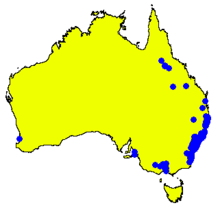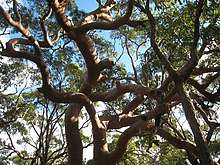Angophora costata
Angophora costata, commonly known as Sydney red gum, rusty gum or smooth-barked apple,[2] is a species of medium-sized to tall tree that is endemic to eastern Australia. It has smooth bark, lance-shaped leaves arranged in opposite pairs, flower buds usually in groups of three, white or creamy white flowers and ribbed, oval or bell-shaped fruit.
| Sydney red gum | |
|---|---|
| Angophora costata in Garigal National Park | |
| Scientific classification | |
| Kingdom: | Plantae |
| Clade: | Tracheophytes |
| Clade: | Angiosperms |
| Clade: | Eudicots |
| Clade: | Rosids |
| Order: | Myrtales |
| Family: | Myrtaceae |
| Genus: | Angophora |
| Species: | A. costata |
| Binomial name | |
| Angophora costata | |
 | |
| Occurrence data from AVH | |
| Synonyms[1] | |
|
Metrosideros costata Gaertn. | |
Description
Angophora costata is a tree that typically grows to a height of 30 m (98 ft) and forms a lignotuber. It has smooth pinkish or cream-coloured bark that weathers to grey and is shed in small scales. It is the only Angophora to have smooth bark on the trunk. Young plants and coppice regrowth have sessile, elliptical to egg-shaped leaves arranged in opposite pairs with a stem-clasping base, 60–125 mm (2.4–4.9 in) long and 20–65 mm (0.79–2.56 in) wide. Adult leaves are arranged in opposite pairs, glossy green but paler on the lower surface, lance-shaped or curved, 70–190 mm (2.8–7.5 in) long and 12–35 mm (0.47–1.38 in) wide on a petiole 9–25 mm (0.35–0.98 in) long. The flower buds are arranged on the ends of branchlets on a branched peduncle 3–25 mm (0.12–0.98 in) long, each branch of the peduncle with usually three buds on pedicels 3–15 mm (0.12–0.59 in) long. Mature buds are oval to globe-shaped, up to 10 mm (0.39 in) long and 11 mm (0.43 in) wide. There are five sepals up to 3 mm (0.12 in) long and the petals are white to creamy white with a green keel, 3–5 mm (0.12–0.20 in) long and 3–6 mm (0.12–0.24 in) wide. Flowering occurs from October to December. The fruit is a oval or bell-shaped capsule up to 20 mm (0.79 in) long and wide.[2][3][4]
Taxonomy and naming
The Sydney red gum was first formally described in 1788 by Joseph Gaertner and given the name Metrosideros costata in his book De Fructibus et Seminibus Plantarum.[5][6] In 1916, James Britten changed the name to Angophora costata in the Journal of Botany, British and Foreign.[7][8]
In 1986, Gregory John Leach described three subspecies in the journal Telopea and two names have been accepted by the Australian Plant Census:[9]
- Angophora costata (Gaertn.) Britten subsp. costata[10] has a glabrous floral cup and fruit mostly less than 15 mm (0.59 in) wide;[2]
- Angophora costata subsp. euryphylla L.A.S.Johnson ex G.J.Leach[11] has a hairy floral cup and fruit more than 15 mm (0.59 in) wide.[2]
The third subspecies, subsp. leiocarpa is regarded as a synonym of Eucalyptus leiocarpa.[12]
Recent genetic work has been published showing Angophora to be more closely related to Eucalyptus than Corymbia, and the name Eucalyptus apocynifolia has been proposed for this species if it were to be placed in the genus Eucalyptus.[13]
Distribution and habitat
Angophora costata grows in sandy soil, often over sandstone and occurs naturally in Queensland and New South Wales. It is widely distributed in south-eastern Queensland and disjunctly in the White Mountains National Park. In New South Wales it mainly occurs in coastal areas south from Coffs Harbour to Narooma and as far west as the Blue Mountains. In Victoria it is a commonly planted ornamental and is naturalised in some places.[4][14]
Use in horticulture
Smooth-barked apple grows well in a variety of situations and can be easily grown from seed in a loose, well-drained seed-raising mixture. Some specimens have straight trunk but others have a more branching habit with twisted trunks. The tree sometimes sheds branches and should not be planted close to buildings.[15]
Significant individuals
Angophora Reserve in the Sydney suburb of Avalon was named after a huge individual, reportedly around 300 years of age. That tree died in the late 20th century.[16] Also in Sydney, the upper Lane Cove River Valley has several large Sydney red gums, one near Conscript Pass was measured at 45 metres tall.[17] The largest known living tree in New Zealand (241 cm diameter) is located at Hobsonville near Auckland.[18]
Gallery
- Features of the Angophora costata
.jpg) Adult leaves
Adult leaves Inflorescence
Inflorescence Fruit with ridges
Fruit with ridges Trunk bark
Trunk bark Shedding trunk bark
Shedding trunk bark Upper trunk
Upper trunk Twisting habit
Twisting habit
References
- "Angophora costata". Australian Plant Census. Retrieved 5 March 2020.
- Hill, Ken; Wilson, Peter. "Angophora costata". Royal Botanic Garden Sydney. Retrieved 5 March 2020.
- Chippendale, George M. "Angophora costata". Flora of Australia. Australian Biological Resources Study, Department of Agriculture, Water and the Environment, Canberra. Retrieved 5 March 2020.
- "Angophora costata subsp. costata". Euclid: Centre for Australian National Biodiversity Research. Retrieved 5 June 2020.
- "Metrosideros costata". APNI. Retrieved 5 March 2020.
- Gaertner, Joseph (1788). De Fructibus et Seminibus Plantarum. Stutgardiae: Sumtibus Auctoris, Typis Academiae Carolinae. p. 171. Retrieved 5 March 2020.
- "Angophora costata". APNI. Retrieved 5 March 2020.
- Britten, James (1916). "The plants of Salisbury's "Prodromus" (1796)". Journal of Botany, British and Foreign. 54: 62. Retrieved 5 March 2020.
- Leach, Gregory J. (1986). "A Revision of the genus Angophora (Myrtaceae)". Telopea. 2 (6): 756–762. Retrieved 4 March 2020.
- "Angophora costata subsp. costata". Australian Plant Census. Retrieved 6 March 2020.
- "Angophora costata subsp. euryphylla". Australian Plant Census. Retrieved 6 March 2020.
- "Angophora leiocarpa". Australian Plant Census. Retrieved 6 March 2020.
- Brooker, M.I.H. (2000), A new classification of the genus Eucalyptus L'Her. (Myrtaceae). Australian Systematic Botany 13(1): 135
- Messina, Andre; Stajsic, Val. "Angophora costata". Royal Botanic Gardens victoria. Retrieved 6 March 2020.
- "Angophora costata". Australian National Botanic Gardens. Retrieved 6 March 2020.
- "'Angophora Reserve, Pittwater Council".
- "Sydney Red Gum - Flickr".
- "Tree Information". The Zealand Tree Register. Retrieved 15 July 2011.